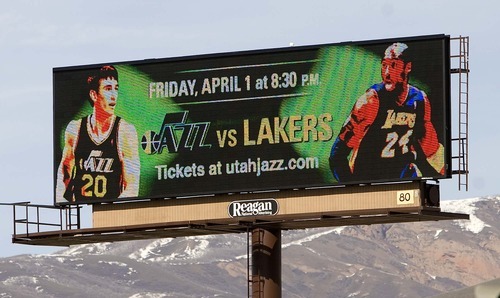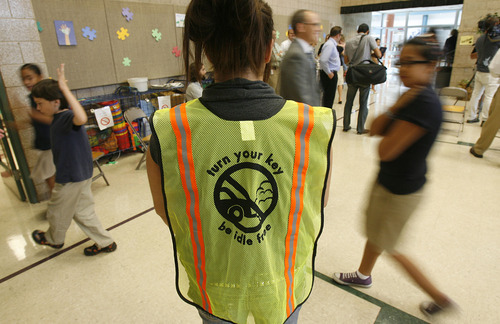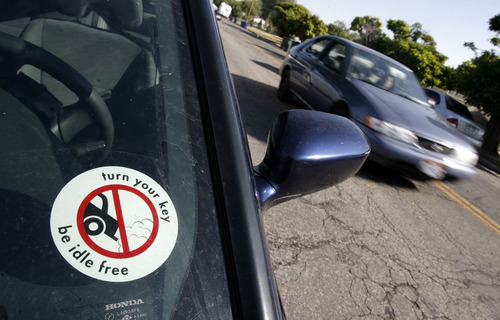This is an archived article that was published on sltrib.com in 2012, and information in the article may be outdated. It is provided only for personal research purposes and may not be reprinted.
Forgive Salt Lake City for feeling like a fighter who has slipped a punch: The pummeling Utah's capital city predicted at the Legislature didn't happen after all.
The bad blood was there. It always courses near a boil between the conservative State Capitol and liberal City Hall. And early in the 2012 session, state lawmakers targeted the city's ability to regulate electronic billboards, vehicle idling and property rights through historic districts. Landlords later joined the mix.
But after 45 days on the ropes, Salt Lake City emerged bruise free, with its progressive policies facing the equivalent of a massage.
A sweeping e-billboard bill — which would have prevented cities and counties from restricting e-signs anywhere — shorted out on the Legislature's last night. The city's anti-idling ordinance simply was tweaked, not overturned. Property-rights advocates and preservationists agreed to punt, for one more year, on the historic-district question.
And Good Landlord programs, on the books in 11 Utah cities, including the capital, were gently amended but mostly untouched. Language exempting state lawmakers from the landlord rules was even erased, under threat of a governor's veto.
"There's certainly a sense of relief on how things played out," says Art Raymond, spokesman for Salt Lake City Mayor Ralph Becker. "It's a victory for local control. And we celebrate that."
That philosophical premise is at the heart of the governing tug of war. While legislators insist they must police "political subdivisions" that get overzealous, local leaders cry hypocrisy, pointing to state lawmakers' war on federal oversight.
—
Compromise elusive • This session's high-wattage fight involved billboards. Becker is pushing new rules that would limit e-signs to freeways, city gateways and commercial corridors — requiring the elimination of a traditional billboard when another is upgraded to LED lighting.
That led executives from Reagan Outdoor Advertising, Young Electric Sign Co. and others to lobby for new statewide standards forbidding cities and counties from passing such restrictions.
"They wanted to be able to convert any billboard anywhere. They never were willing to come off of that," says Salt Lake City Planning Director Wilf Sommerkorn about the industry. "There were enough senators who were not comfortable with it that they were never able to get a majority to pass the bill."
Jeff Young, vice president of YESCO, disputes that the industry was inflexible. "The bottom line is we just ran out of time."
He says the bill was redrafted multiple times after input from the League of Cities and Towns and stresses that a controversial clause on arbitration was dropped. "It's unfortunate that the bill didn't get to the floor for a vote," Young adds. "We think it would have passed."
The league was willing to grant conversions along freeways but not surface streets — a compromise the billboard industry rejected.
City lobbyist Lynn Pace said had that proposal been accepted, "it would have been done."
Now, the city is considering rules that require the elimination of two regular billboards for every e-sign conversion, though Sommerkorn says his proposed ratio was six to one or even eight to one, given that e-signs have rapidly changing messages. The battle is poised to play out before the City Council, but Young sounds unwilling to back down.
"We've been very clear on our disagreement with them asking us to shut down half of our business to improve it," he says. "You think of this in terms of any other industry and you scratch your head and say, 'When the economy is the way it is, why would the city be taking actions to try to suppress business improvements?' That's been perplexing to us."
—
Why other threats fizzled • Salt Lake City's two-minute limit for vehicle idling also survived after intense negotiations. The ordinance carries fines for second offenses and beyond but is regarded more as an educational tool than a revenue maker.
Raymond defends the mayor's edict, pointing to a new study that reveals 55 percent of the city's gunky air comes from automobiles.
In a bit of a truce with state lawmakers, the city agreed to soften the private-property section. Now, the idling cap on private property can be enforced only in places the public gathers, like parking lots, but not on residential driveways.
Pace says the city avoided what could have been a complete prohibition on car-idling laws and made only minor concessions. That, in turn, could make similar idling laws attractive for other cities to enact as they look for ways to improve air quality, Pace says. "That's a huge success."
Despite the host of lawmakers active in real estate and property management, only minor changes were made to the so-called Good Landlord laws. Now, landlords have to take the training only once, even if they manage properties in multiple cities. Also, if landlords have a single unit, duplex, triplex or fourplex that is owner occupied, they are now exempt from the Good Landlord program.
City leaders and legislators also worked together to adopt a second-straight one-year moratorium on the creation of historic districts in Salt Lake City. The reason, politicians said, is that residents in Yalecrest remain divided on the subject and need another year to forge a compromise. So instead of an outright ban, or some daunting threshold to delineate historic districts, Raymond notes the city achieved a "positive" pause.
So how did so many threats fizzle? And how did the Legislature's favorite whipping boy fare so well after all?
Pace says many of the bills were designed simply to grab attention and had little chance of actual passage. "Once all the voices are heard," he explains, "you end up with a more moderate position."







